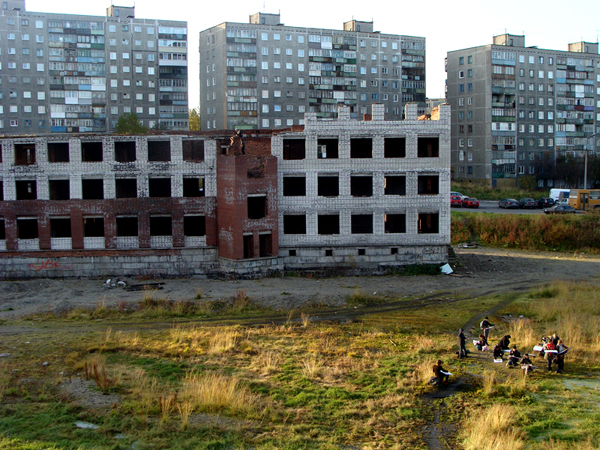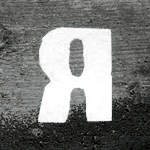Me and Russia - Mumansk Motion 2009

Photo by Grigorij Pisarenko
In 2007,
I had the opportunity to experience
something that changed my
life. I made my three first journeys to Russia. I travelled the country
in an unusual order: from north to south, and then back to north.
Usually St. Petersburg is the first and often the only city in Russia
where Finns travel. I, for my part, travelled first to Murmansk, where
I experienced the peculiar and vast northern city with its massive grey
apartment buildings in the midst of fells. The landscape really got
under my skin. There I understood that I could never understand Russian
culture and people properly without Russian language. So I started to
learn it. In that time Russia began to be visible in my artworks too.
In my art I approach this foreign culture in the same time from near
and far, from my own context.
I spent the academic year 2008–2009 as an exchange student in
Stieglitz St. Petersburg State Academy of Art and Industry in the
faculty for decorative and applied arts, and in the summer of 2009 I
travelled on the Trans-Siberian Railway across the country all the way
to Vladivostok on the shore of the Sea of Japan. In May 2010 I had an
exhibition in Kilo-gallery in the University of Lapland. It was telling
real stories about my trips in the strange country living in its own
reality, what is a strange mix of past and present time.
Nevertheless, the very first city I ever visited in Russia continues to
bear the most significant meaning to me. The powerful place experience
I had in Murmansk has also influenced all my subsequent experiences in
our vast neighbouring country. I keep unintentionally comparing all new
cities and places Murmansk, which to me represents the imaginary ideal
city far away in the North. It is a peculiar sea of grey building
masses in the midst of distant fells, a Soviet heroic city on the Kola
Peninsula. I wanted to return to this city once again. Luckily, I had
an opportunity to plan and implement a workshop in Murmansk as a part
of my art education studies and my thesis. In my thesis I wanted to
focus on the place-specific experiences of Murmanskian youth.
I implemented the city art workshop for the local art students in
Murmansk during the 1st through 4th of October 2009 as a part of the
international Pan Barentz project, which studies the architecture,
means of livelihood and identity in the Arctic cities through the means
of modern art. While the Pan Barentz exhibition was on display in the
city, students of the Murmansk Art School and Art Institute examined
their own cityscape through croquis exercises and drawings and finally
through making of stop-motion videos.
The workshop was begun by drawing a black-and-white sketch of the city
of Murmansk and then colouring the sketch with colours that best
describe the city. After this, the participants applied their minds to
conducting observation-based place analyses by exploring various urban
locations in the vicinity of the school by walking, drawing sketches,
and listening to the sounds of the location. The city croquis exercise
focused on finding the key structures, lines and shapes constituting
the specific locations and the city of Murmansk. The same locations
served also as the subject for colour studies focusing merely on the
colour worlds of the locations.
Then the
participants formed groups and selected a
shared favourite location and the most disliked location and then
familiarised themselves with these locations to a greater depth by
conducting a place analysis according to what they had earlier learned.
Lastly, the groups transfigured the unpleasant location into a more
pleasant and welcoming one with stop-motion animation. These videos
have been seen in the exhibitions at the Napa Gallery at the Rovaniemi
library between Nov 3 and Nov 18, 2009 and in the University of Lapland
during the Insea conference between July 21 and July 24, 2010. To
conclude the workshop, the participants drew finally a sketch of the
future Murmansk of their dreams.
The workshop provided the participants with an opportunity to stop and
contemplate their familiar surroundings from a fresh perspective and by
utilising new methods, conversing and working as a group. The
participants spent time at the locations, wondered, marvelled, feared
and were surprised – in other words, they experienced. The
workshop also provided the young Murmanskian artists with new means of
expression for their artistic work in terms of modern art. Moreover,
teachers of the art school expressed an awoken enthusiasm in utilising
the exercises and methods of the workshop as a part of their own
teaching methods. At the closing celebration of the workshop, the
finished video works were reflected on the grainy outside wall of the
art school. The release of these works became a spatial city art event,
a celebration at the school yard, one which will most likely be
followed by others.
This workshop gave me good material for my thesis. My research material
consists of questionnaires, interviews and videos. In the videos the
young participants reformed and seemed to “clean
up” the
unpleasant places mostly with the methods of play, humour and bright
colours. For these artists and art-students social was even more
important than the visual appearance in these uncomfortable places.
It is probably impossible for me to ever master the Russian culture and
language flawlessly, as is the case for most things in life. So, I will
continue my travelling and working in Russia as an artist and as an
art-educator. I have had exhibitions in Russia and new ones will be
coming. I’ve been planning new projects in which I will
continue
to improve my methods of studying the surrounding environments through
art.
